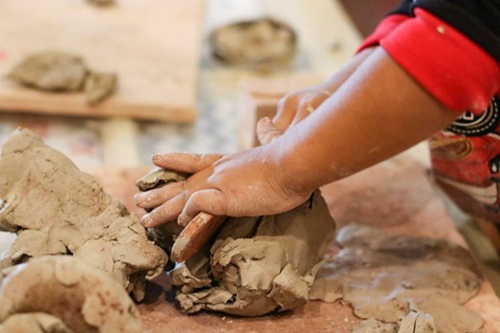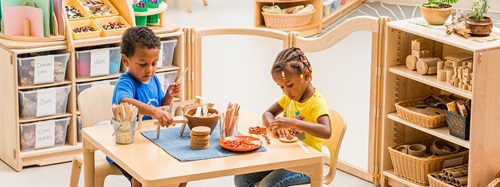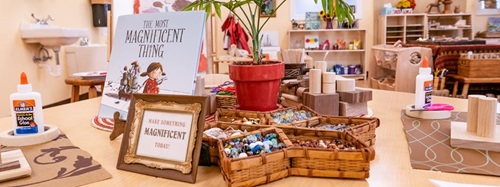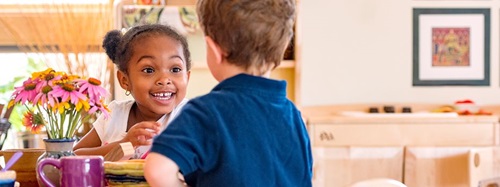Drawing from the Reggio Emilia Approach:
Inspiring Connection, Creativity, and Curiosity in the Classroom
| June 2022Standing in a classroom I see a child pick up a magnifying glass. She starts exploring the growth of the plants from a class planting project several weeks ago. I see a small group of children creating tile mosaics based on ancient artifacts they’ve been studying. I see several other children dancing in front of a light, watching their shadows move and play across the wall. The children’s work is displayed around the room and I get an overwhelming feeling that the space is created entirely for their creativity and exploration.
This is a Reggio Emilia inspired classroom. The Reggio Emilia approach to early education is a philosophy that values the child and embraces their individuality, creativity, and curiosity.
Background and History
The Reggio Emilia approach, named for its founding city, began in Reggio Emilia, Italy as a response to the effects of WWII on the country. A group of parents, led largely by mothers, in the Reggio Emilia area were inspired by a desire to teach their children in a new innovative way. The parents built the first preschool and asked Loris Malaguzzi to help teach their children. Malaguzzi, a local teacher and psychologist, partnered with the parents to ensure the school flourished. He worked with the municipality to establish other preschools and expanded the reach of the Reggio Emilia approach.
Thanks to Malaguzzi’s efforts, the Reggio Emilia approach has spread worldwide. It’s an approach to draw inspiration from, not a formal accreditation or certification process, which is what makes this approach applicable to many diverse settings. The Reggio Emilia philosophy is a child-centered approach to teaching, learning, and advocating for young children. Because it embraces the culture and strengths of each child, it can be applied to schools across the world. The child-centered asset-based approach to learning is evident in the idea of a child’s 100 languages.
100 Languages
A child’s 100 languages, refers to their potential. The Reggio approach uses the idea of 100 languages to show the many different ways each child experiences the world, expresses themselves, and develops skills. The idea of 100 languages celebrates each child’s unique abilities, strengths, and experiences. It brings value to what the child can do and puts the child at the center of focus. The child becomes the protagonist, or main character, with an active role in the learning process. The Reggio approach considers three primary influences on the child’s learning process, referred to as “the three teachers”.
The Three Teachers
The three teachers in a child’s life, based on the Reggio Emilia approach are: the child’s parents, the classroom teacher, and the environment. The child is the focus, the main character, with the supporting roles going to each of the three teachers. The family, classroom teacher, and environment are intertwined and work together to support the child’s development. The child needs to have rich meaningful interactions with all three.
The Family
Families are the experts on their child, their role and input should be valued. A reciprocal partnership can be formed to create a meaningful home-school connection.
Drawing from the Reggio approach, teachers can:
- Seek information from parents about family culture, background, and dynamics
- Ask about family goals/expectations for the child and the child’s interests at home
- Share photos, anecdotes, or other forms of documentation with parents illustrating the child’s interests, projects, and work from school
The Classroom Teacher
The classroom teacher’s role in a child’s learning is to be a facilitator, co-learner, active observer, and collaborator.
Drawing from the Reggio approach, teachers can:
- Embrace the child’s 100 languages (allow for exploration, mistakes, and the opportunity to find solutions); learning and growth is layered in the Reggio approach, allow time for deeper learning to occur
- Form meaningful relationships with each child (actively engage and help bridge connections; learn with and from them)
- Actively observe to gain understanding and learn from the child (rather than directing them)
- Self-reflect and collaborate with fellow teachers
The Environment
A child’s environment should be free-flowing and promote play, exploration, learning, and creativity.
Drawing from the Reggio approach, teachers can:
- Create a space that promotes connection, community, and belonging (children are well-represented in the classroom and there’s space for individual, small, and large group play)
- Create a space that feels home-like (materials arranged on tables/shelves in an inviting way that sparks curiosity, use natural light, lamps, and baskets)
- Put the same effort into the outdoor classroom as the indoor classroom (both should be well-planned, intentional, and valued)
Vehicles for Learning
The Reggio approach supports four key vehicles for learning: an emergent curriculum, in-depth projects, representational development, and collaboration.
An emergent curriculum is derived from the child’s interests and ensures engagement in the learning topic. Many American preschools follow a prescribed set curriculum with certain topics and activities to be completed each week. Remember, the Reggio Emilia approach is a guide to draw inspiration from, so think creatively about how to make a prescribed curriculum have emergent elements.
Ideas for the classroom:
- Create an “interests” board on the wall in the classroom with photos and text that can be changed based on children’s changing interests
- Dedicate part of circle time to learning about topics children are interested in; ask children what they already know and what they wonder—explore those questions
- Let the children decide the theme for one learning area each month
In-depth projects are deeper studies of concepts and ideas rooted in children’s interests. In the Reggio approach they are often called adventures and can last a couple of weeks or span the whole school year.
Ideas for the classroom:
- Study topics children are interested in more deeply (in-depth study of dinosaurs or animals found in savannahs); some topics can roll into the next
- Integrate topics for a continued in-depth study (integrate the life cycle of a butterfly with pollination, animal migration, geography, insect life, or a gardening activity)
- Document the learning process throughout the study (take photos, write down children’s words, save work samples) and refer back to them during circle time and free play for reflection and continued discovery
Representational development refers to the many ways content can be presented to children (print, art, drama, construction, dance, music, puppetry, shadow play, etc.). Children learn differently, through their 100 languages; varied presentations of content ensure all children have the opportunity to connect with and understand concepts.
Ideas for the classroom:
- Provide content through various modes (act out the weather, create a class-made book, take art outside)
- Integrate learning areas to expand knowledge (add art or writing to the science area, add books to the block area, create a dramatic play area outside)
Collaboration with peers, teachers, and the environment are important in the Reggio inspired learning process. Collaboration supports problem-solving, dialogue, and ensures each child’s voice is heard.
Ideas for the classroom:
- Ask children throughout the day or at circle time about their interests
- Encourage peers to help each other and learn from one another in play
Research-based benefits
A child-centered approach to education, like the Reggio Emilia approach, is extremely beneficial to a child’s development. It encourages equitable learning as each child is valued and seen with the right to knowledge, education, and interactions that support their best selves. It teaches inclusivity through community building, self-respect, and respect for others. Collaboration promotes language development, social skills, cognitive development, and executive function skills. The Reggio approach also strengthens family partnerships and creates a home-school collaboration, which is extremely beneficial for child development.
Be Inspired
It’s hard to not be inspired from the Reggio Emilia approach. When making changes to your classroom, remember to start small. Think about what can easily be changed or how to use what you already have in a different way. Think outside of the box about what aspects of your curriculum could be more emergent. Teaching practices get changed through habit. Set goals to start actively observing, to take notes on children’s play and interests, and take photos to document learning. Involve families and create a learning environment that is representative of the children in your classroom. Bring the outdoors in and the indoors out. Before long, you’ll have a Reggio inspired classroom Loris Malaguzzi would take pride in.
References
Biermeier, M. A. (2015, November). Inspired by Reggio Emilia: Emergent curriculum in relationship-driven learning environments. https://www.naeyc.org/resources/pubs/yc/nov2015/emergent-curriculum
Flavin, B. (2020, February 24). What is Reggio Emilia? Your guide to this child driven approach. Rasmussen University. https://www.rasmussen.edu/degrees/education/blog/what-is-reggio-emilia/
Grand Rapids Child Discovery Center. (n.d.) What is the Reggio Emilia approach?.
https://childdiscoverycenter.org/non-traditional-classroom/what-is-the-reggio-emilia-approach/
Picture Perfect Playgrounds. (n.d.). Loris Malaguzzi. Play and Playground Encyclopedia. https://www.pgpedia.com/m/loris-Malaguzzi
Reggio Emilia Approach. (n.d.). Reggio Emilia approach. https://www.reggiochildren.it/en/reggio-emilia-approach/
Stoudt, A. (n.d.). The Reggio Emilia approach. Scholastic. https://www.scholastic.com/teachers/articles/teaching-content/reggio-emilia-approach/
The Scotts College Sydney Australia. (2017, November 21). What is the Reggio Emilia philosophy? https://www.tsc.nsw.edu.au/what-is-the-reggio-emilia-philosophy/)











